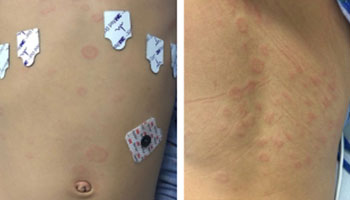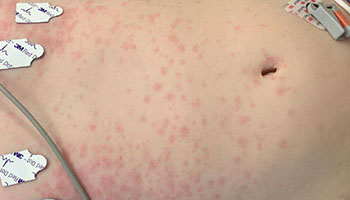HOW CAN WE HELP YOU? Call 1-800-TRY-CHOP
In This Section
Could Photos of Rashes Help Clinicians Diagnose MIS-C?

Diagnosing MIS-C is challenging for clinicians as many of its symptoms, including rash and fever, are common in other pediatric conditions.
The findings:
Through a retrospective review of images of dermatologic manifestations of Multisystem Inflammatory Syndrome in Children (MIS-C) in patients at Children’s Hospital of Philadelphia, researchers at CHOP presented an educational case series of photos and descriptions to aid healthcare providers in recognizing rash as a significant component of initial disease presentation for the diagnosis of future cases.
Why it matters:
Early in the COVID-19 pandemic, doctors began to recognize a novel, pediatric systemic inflammatory syndrome, thought to be a post-infectious complication of SARS-CoV-2 infection and termed it MIS-C. Diagnosing this syndrome is challenging for clinicians as many of its symptoms, including rash and fever, are common in other pediatric conditions. While other case series suggest that a majority of children with MIS-C have dermatological changes, these findings are not yet well documented. This research presents photographs and descriptions of seven children with MIS-C, including children with a diversity of skin tones and pigmentation.
Who conducted the study:

Annular plaques on the torso and back of patients with MIS-C.
Audrey Odom John, MD, PhD, chief of the Division of Infectious Diseases was senior author, and Allison Blatz, MD, a fellow in the same Division, was first author. Michelle Oboite, MD; Kathleen Chiotos, MD, MSCE and Leslie Castelo-Soccio, MD, PhD; were contributing authors.
How they did it:
An expert multidisciplinary team routinely evaluated all children admitted to CHOP with concern for MIS-C, per Center for Disease Control criteria, to reach diagnostic consensus. Skin findings were photographed and included in the electronic health record, and clinical characteristics were abstracted through chart review.
The research team analyzed the MIS-C-associated rashes of seven CHOP patients. Although the researchers did not observe a single, defining rash associated with COVID-19, there were several types of rashes that were common in these patients, both in appearance and location.
All patients in the study developed a rash on their lower body, and five of the seven patients had a rash on their inner thighs. Rashes on the chest and upper extremities were also common, occurring in four out of seven patients.
Four of the seven patients presented with small-to-medium annular plaques, or ring-like skin lesions the size of a dime, on their chest and back. More than half of the patients in the study also developed purpura, tiny red spots, often in the center of the annular plaques.
Quick thoughts:

Rash on the torso of a patient with MIS-C.
“Depending on the age of the child, parents may not regularly look at the child’s chest, back, or thighs, but this is where the rashes associated with MIS-C tend to appear,” explained Dr. John, who was recently awarded an NIH emergency grant to study MIS-C diagnostics. “Given that MIS-C is still largely a diagnosis of exclusion, parents and healthcare providers should look for rashes in these locations if the child has a fever that seems suspicious.
“Obviously a ‘picture is worth a thousand words,’ and since early in this pandemic, making the diagnosis of MIS-C has been a big challenge,” she continued. “Our team felt it was important to make these images available to help clinicians who are taking care of children with fever in the time of COVID-19. Since many of the other descriptions of COVID rashes in children have been published from groups in Europe, we also felt it was an important contribution to show what MIS-C rashes look like in children with darker skin tones.”
Where the study was published:
The study appeared in Open Forum Infectious Diseases.
Want to learn more?
Check out this CHOP press release.


